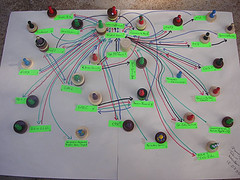political economy

Collaborative Stakeholder Mapping to Promote Legal Timber Trade
CHALLENGE
Russian Far East forest is one of the world’s most unique ecosystems, containing valuable timber species and habitat of rare Amur tigers. However, timber trade (and often times illegal logging) to satiate Chinese and subsequently international timber demand is straining the region’s ecosystem, causing irreversible ecological, economic and social consequences. The full impact of illegal logging on government revenues and on the livelihoods of local communities is uncertain (refer to Methodology for Calculating Budget Losses and Local Revenue Impacts of Illegal Logging); however, the Forest Agency of the Russian Federation estimated the damage for 2013 at $320.2 million.
Due to the complex economic, political and legal makeups of this cross-border problem, illegal logging has been persistent and escalating. Thus, having an understanding of the political economy of the forest sector in this region is the crucial first step toward sustainable forest management. The second step would be to stimulate discussion between Russian and Chinese authorities; and collectively design a common long term strategy with realistic, accountable, measureable goals.
APPROACH
This activity demonstrates the application of an innovative stakeholder mapping methods – Net-Map – as both an empirical research tool and a development instrument for project design and implementation. Net-Map visualizes the complex timber trade network through interviewing diverse groups of forest stakeholders. These participatory workshops elicit the complex maps of actors, their relationships (both formal and informal), actors’ goals and incentives as well as their influences. Using social network approaches, the governance network is analyzed and the rich discussion during the workshop adds to the understanding of the structure and function of the network as well as actors.
This project explicitly focuses on the role of networks, connections and power analysis in generating collaborative solutions to promote the legal trade in timbers. By adopting a participatory, people-centered approach to problem analysis and identification of entry points for reform, the work aims to build momentum and consensus around realistic actions.
RESULTS
This activity is ongoing. Findings will be shared on this page when they become available. For stories and updates on related activities, follow us on Twitter and Facebook, or subscribe to our mailing list for regular updates.
For stories and updates on related activities, follow us on twitter and facebook , or subscribe to our mailing list for regular updates.
Last Updated : 06-15-2024








